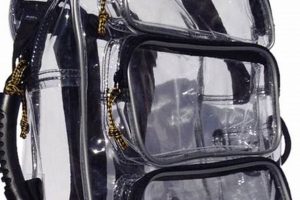The process of maintaining the cleanliness of a North Face backpack involves several steps to ensure its longevity and optimal performance. This includes removing dirt, stains, and odors accumulated through regular use. Proper cleaning prevents the deterioration of the fabric and components, contributing to the backpack’s overall lifespan.
Regular maintenance of a backpack provides several benefits. It prevents the buildup of grime that can degrade the material, reduces the risk of mold or mildew growth, and ensures that zippers and buckles function correctly. Historically, backpack cleaning was often neglected, leading to premature wear and tear. Today, with increased awareness of textile care, individuals are more likely to adopt proper cleaning practices.
The following sections will provide a detailed guide on appropriate cleaning methods, covering pre-cleaning preparations, hand-washing techniques, stain removal procedures, and drying recommendations. These instructions are designed to help effectively and safely clean the item without causing damage.
Cleaning North Face Backpacks
Effective cleaning extends the lifespan and performance of a North Face backpack. The following tips provide a structured approach to maintaining its condition.
Tip 1: Empty All Pockets and Compartments: Before initiating any cleaning process, ensure the backpack is completely empty. Forgotten items can cause staining or damage during washing.
Tip 2: Pre-Treat Stains: Address specific stains before washing. Use a mild detergent or stain remover, applying it directly to the affected area and allowing it to sit for approximately 15-30 minutes.
Tip 3: Hand Wash with Mild Detergent: Washing by hand is generally recommended to avoid damage from machine agitation. Use a mild, pH-neutral detergent formulated for delicate fabrics.
Tip 4: Use Cold Water: Cold water helps prevent color fading and shrinkage. Ensure the water temperature is consistently cool throughout the washing process.
Tip 5: Rinse Thoroughly: After washing, rinse the backpack thoroughly to remove all traces of detergent. Residual detergent can attract dirt and cause stiffness in the fabric.
Tip 6: Air Dry in a Shaded Area: Avoid direct sunlight, as it can cause fading and material degradation. Hang the backpack upside down or lay it flat in a well-ventilated, shaded area.
Tip 7: Address Stubborn Odors: If odors persist, consider using a fabric refresher spray or placing an open box of baking soda inside the backpack for several days to absorb unwanted smells.
Implementing these tips will help maintain the cleanliness and integrity of the backpack. Consistent and careful cleaning practices contribute to its long-term usability and appearance.
The subsequent sections will elaborate on specific cleaning techniques and preventative measures to ensure optimal backpack care.
1. Empty all pockets
The initial step in the process of cleaning a North Face backpack is the complete removal of all contents from its pockets. This preliminary action is fundamental to ensuring a thorough and effective cleaning process, as well as preventing potential damage to both the backpack and any items inadvertently left inside.
- Prevention of Damage to Contents
Retaining items within the backpack during cleaning can lead to their damage or contamination. Electronic devices may be rendered inoperable if exposed to water, while paper-based items can disintegrate, causing further cleaning complications. Emptying all pockets mitigates the risk of such damage and ensures that the cleaning process remains focused on the backpack itself.
- Facilitation of Thorough Cleaning
Pockets often accumulate dirt, debris, and small objects that can hinder the cleaning process. Leaving items inside restricts access to the interior of the pockets, preventing a comprehensive removal of grime and potentially masking stains. Emptying the pockets allows for unobstructed access and ensures that all surfaces can be effectively cleaned.
- Avoidance of Stain Transfer
Items such as pens or markers left inside pockets may leak during the cleaning process, causing ink stains on the backpack’s interior. Similarly, colored items could bleed, transferring dye onto the fabric. Removing all items eliminates the possibility of such stain transfers, preserving the aesthetic quality of the backpack.
- Prevention of Mold and Mildew Growth
Damp or organic materials, such as food wrappers or wet wipes, left inside pockets can create an environment conducive to mold and mildew growth. This not only produces unpleasant odors but can also degrade the backpack’s fabric over time. Emptying the pockets ensures that no such materials remain, preventing the development of mold and mildew.
The seemingly simple act of emptying all pockets is, therefore, a critical prerequisite for effective backpack cleaning. It addresses multiple potential issues, from preventing damage and stain transfer to facilitating a thorough cleaning and inhibiting microbial growth. By prioritizing this initial step, individuals can ensure that the cleaning process is both efficient and effective, ultimately contributing to the longevity and usability of the North Face backpack.
2. Pre-treat any stains
Addressing stains prior to a comprehensive cleaning regimen is a critical step in the proper maintenance of a North Face backpack. This proactive approach enhances the overall effectiveness of the cleaning process and contributes to the preservation of the fabric’s integrity and appearance.
- Enhanced Stain Removal Efficacy
Pre-treating stains increases the likelihood of their complete removal during subsequent washing. By applying a targeted cleaning agent directly to the affected area, the stain particles are loosened and broken down, rendering them more susceptible to removal during the main cleaning phase. Failure to pre-treat may result in the stain becoming permanently embedded in the fabric fibers.
- Prevention of Stain Spreading
Certain stains, if left untreated, can spread during the washing process, potentially affecting a larger area of the backpack. Pre-treatment helps to contain the stain, preventing it from migrating and causing further discoloration or damage. This localized approach minimizes the risk of widespread contamination.
- Preservation of Fabric Integrity
Aggressive scrubbing or the use of harsh chemicals on untreated stains can compromise the fabric’s structural integrity, leading to fading, weakening, or even tearing. Pre-treatment allows for a gentler approach, utilizing specialized cleaning agents that effectively target the stain without causing damage to the surrounding material. It is a preventative measure to keep the fabric strong.
- Targeted Application of Cleaning Agents
Different types of stains require specific cleaning agents for optimal removal. Pre-treatment enables the selection and application of the most appropriate cleaning solution for the particular stain type, whether it be grease, ink, mud, or food residue. This targeted approach ensures that the stain is effectively addressed without unnecessarily exposing the entire backpack to potentially harsh chemicals.
Therefore, the practice of pre-treating stains on a North Face backpack is not merely an optional step, but an integral component of a thorough and effective cleaning process. By addressing stains directly before washing, one maximizes the chances of complete stain removal, minimizes the risk of fabric damage, and ultimately contributes to the long-term maintenance and aesthetic appeal of the backpack.
3. Hand wash gently
The practice of gentle hand washing is a crucial component in the proper maintenance and cleaning of a North Face backpack. This method mitigates risks associated with more aggressive cleaning techniques, contributing to the longevity and preservation of the backpack’s materials and structural integrity.
- Preservation of Fabric Integrity
Harsh washing methods, such as machine washing, can cause significant damage to the specialized fabrics used in North Face backpacks. The abrasive action of a washing machine can weaken fibers, leading to premature wear and tear. Gentle hand washing minimizes this risk by applying only the necessary amount of force to remove dirt and grime, preserving the fabric’s strength and water-resistant properties.
- Protection of Delicate Components
North Face backpacks often feature intricate components, including zippers, buckles, and specialized padding. Machine washing can damage or dislodge these elements, compromising the backpack’s functionality. Hand washing allows for precise control over the cleaning process, enabling careful attention to these delicate components and preventing potential damage.
- Avoidance of Color Fading and Dye Bleeding
Aggressive washing can cause color fading and dye bleeding, particularly in backpacks with vibrant colors or intricate designs. Gentle hand washing, using cold or lukewarm water and a mild detergent, helps to prevent these issues, preserving the backpack’s aesthetic appearance. It ensures the colors remain vibrant and prevents unwanted dye transfer.
- Targeted Stain Removal
Hand washing facilitates targeted stain removal, allowing for focused attention on specific areas of concern. Instead of subjecting the entire backpack to a potentially harsh cleaning process, individual stains can be addressed with appropriate cleaning agents and gentle scrubbing, minimizing the risk of damage to the surrounding fabric. This precise approach is particularly beneficial for removing stubborn stains without compromising the overall integrity of the backpack.
The emphasis on gentle hand washing in the context of cleaning a North Face backpack underscores the importance of a deliberate and controlled approach. By prioritizing fabric preservation, component protection, color retention, and targeted stain removal, this method ensures that the backpack remains functional, aesthetically pleasing, and durable for extended use. The technique stands as a cornerstone of effective and responsible backpack maintenance.
4. Air dry thoroughly
The thorough air-drying process is an indispensable step following any cleaning procedure applied to a North Face backpack. It addresses critical aspects of material integrity, mold prevention, and overall backpack longevity, extending beyond mere surface dryness.
- Prevention of Mold and Mildew Growth
Residual moisture trapped within the backpack’s fabric or compartments fosters an environment conducive to mold and mildew proliferation. These microorganisms degrade the material, causing unpleasant odors and potential allergic reactions. Thorough air-drying, particularly in well-ventilated areas, eliminates this moisture, preventing microbial growth and preserving the backpack’s hygienic condition. This step is important for not only cleanliness but also health.
- Maintenance of Fabric Integrity
Prolonged dampness can compromise the fabric’s strength and water-resistant properties. Certain materials are prone to hydrolysis, a chemical reaction with water that leads to polymer breakdown. Air-drying facilitates the evaporation of moisture, preventing this degradation and maintaining the backpack’s original functionality and structure. This ensures the backpack continues to provide the protection it was designed for.
- Preservation of Hardware Functionality
Metal components, such as zippers and buckles, are susceptible to corrosion when exposed to prolonged moisture. Rust formation can impede their smooth operation, eventually leading to failure. Thorough air-drying ensures these components remain dry, preventing corrosion and maintaining their functionality over extended periods of use. Functionality is one of the main objectives with this type of bag.
- Prevention of Odor Retention
Trapped moisture can trap odors within the fabric fibers, resulting in a persistent musty smell. Air-drying, especially in open spaces, allows these odors to dissipate, leaving the backpack fresh and ready for subsequent use. Using natural air fresheners in conjunction with air-drying can further enhance odor elimination. This promotes a more pleasant experience when using the item.
The meticulous execution of the air-drying process is therefore integral to the overall strategy for maintaining a North Face backpack. It addresses multiple potential issues, ensuring that the backpack remains clean, functional, and durable. This final stage in the cleaning process is vital for protecting the investment and maximizing the usable lifespan of the item.
5. Mild soap preferred
The selection of an appropriate cleaning agent is critical when addressing the process of cleaning a North Face backpack. The term “mild soap preferred” indicates a deliberate recommendation against the use of harsh detergents or abrasive chemicals, highlighting the potential for damage that such substances can inflict on the specialized materials and construction of these backpacks.
- Preservation of Water-Resistant Coatings
Many North Face backpacks feature durable water repellent (DWR) coatings. Harsh detergents can strip these coatings, diminishing the backpack’s water resistance. Mild soaps, formulated with gentler surfactants, effectively remove dirt and grime while preserving the integrity of the DWR treatment. Selecting appropriate soap maintains the water proof and water repellent of the bag.
- Prevention of Fabric Degradation
Aggressive cleaning agents can weaken or break down the fibers of the backpack’s fabric, leading to premature wear and tear. Synthetic materials, such as nylon and polyester, are particularly susceptible to damage from harsh chemicals. Mild soaps provide a gentler alternative, cleaning the fabric without compromising its structural integrity. Avoiding corrosive soap is a good method of cleaning the item.
- Minimization of Color Fading and Dye Bleeding
Harsh detergents can cause colors to fade or bleed, especially in backpacks with vibrant hues or intricate designs. Mild soaps are less likely to cause these issues, helping to maintain the backpack’s aesthetic appeal. Washing in cold water also helps to minimize this risk.
- Reduction of Residue Build-Up
Some detergents leave behind a residue that can attract dirt and grime, negating the benefits of cleaning. Mild soaps are typically formulated to rinse cleanly, minimizing residue build-up and ensuring the backpack stays cleaner for longer. Rinsing with clean water is always important, as this helps the soap clean easier.
In summary, the preference for mild soap in the context of backpack maintenance underscores a proactive approach to safeguarding the backpack’s material properties, water resistance, and aesthetic qualities. Choosing appropriate soap is integral to an effective cleaning routine that extends the lifespan and functionality of the item.
6. Avoid machine wash
The instruction to “Avoid machine wash” is a critical directive when considering the appropriate methods for maintaining a North Face backpack. Machine washing poses significant risks to the structural integrity and specialized features of these products, necessitating alternative cleaning approaches.
- Preservation of Specialized Fabrics
North Face backpacks often utilize technical fabrics engineered for water resistance, durability, and lightweight performance. The agitation and abrasion inherent in machine washing can compromise these properties, leading to premature wear, delamination of coatings, and reduced overall functionality. The structural design can be ruined by machine agitation and high speed. Machine washing is not appropriate in most cases.
- Protection of Structural Components
Backpacks incorporate various structural elements, including internal frames, padded compartments, and intricate stitching. Machine washing can distort these components, causing them to shift, break, or lose their shape. This can negatively impact the backpack’s load-bearing capacity and overall comfort. The structural design can easily break because of machine speed and power.
- Mitigation of Hardware Damage
Zippers, buckles, and other hardware components are vulnerable to damage during machine washing. The forceful tumbling action can cause these elements to break, bend, or become detached from the backpack. Such damage can render the backpack unusable or necessitate costly repairs. Damage to this important component is a likely concern. It will affect the bag use in many different ways.
- Prevention of Color Fading and Dye Transfer
The aggressive cleaning action of machine washing, combined with the use of conventional laundry detergents, can cause colors to fade or bleed, especially in backpacks with multiple colors or intricate designs. This can significantly diminish the backpack’s aesthetic appeal. Colors fading away will change the way the bag looks, making it older and worn down quicker.
Therefore, the recommendation to “Avoid machine wash” serves as a fundamental principle in the proper care and maintenance of North Face backpacks. Adhering to this guideline helps to preserve the backpack’s specialized features, structural integrity, and aesthetic qualities, ensuring its continued performance and longevity. The method in which it’s cleaned dictates the life of the bag.
Frequently Asked Questions
The following section addresses common inquiries regarding the proper methods for maintaining the cleanliness of North Face backpacks. These questions and answers are designed to provide clarity and guidance for effective and safe cleaning practices.
Question 1: Can a North Face backpack be machine washed?
Machine washing is generally discouraged. The abrasive action can damage specialized fabrics, coatings, and structural components. Hand washing is the recommended alternative.
Question 2: What type of detergent is suitable for cleaning?
A mild, pH-neutral soap or detergent is preferred. Harsh chemicals can degrade the fabric and diminish water resistance. Avoid products containing bleach or fabric softeners.
Question 3: How should stains be addressed on the backpack?
Pre-treatment is essential. Apply a small amount of mild detergent or stain remover directly to the affected area. Allow it to sit for 15-30 minutes before washing.
Question 4: What is the best method for drying the backpack?
Air drying in a shaded area is recommended. Direct sunlight can cause fading and material degradation. Ensure the backpack is thoroughly dry before storing it.
Question 5: How can odors be removed from the backpack?
After cleaning and drying, place an open box of baking soda inside the backpack for several days. Fabric refresher sprays can also be used sparingly.
Question 6: How often should the backpack be cleaned?
Cleaning frequency depends on usage. A general guideline is to clean the backpack every few months or as needed based on visible dirt or odors. Regular spot cleaning can also help maintain its condition.
Consistent application of these practices will contribute to the longevity and optimal performance of the backpack.
The subsequent section will detail preventative measures to minimize the need for frequent cleaning.
Concluding Remarks on Maintaining North Face Backpacks
The preceding discussion has outlined the essential procedures associated with maintaining a North Face backpack. Key considerations encompass pre-cleaning preparations, appropriate washing techniques, stain removal strategies, and effective drying methods. Adherence to these guidelines contributes significantly to the longevity and performance of the product.
The ongoing commitment to appropriate maintenance practices ensures that the North Face backpack remains a reliable and functional asset. Consistent and informed care safeguards the investment, maximizing its lifespan and utility across diverse applications. The informed consumer understands the value of proper upkeep.







